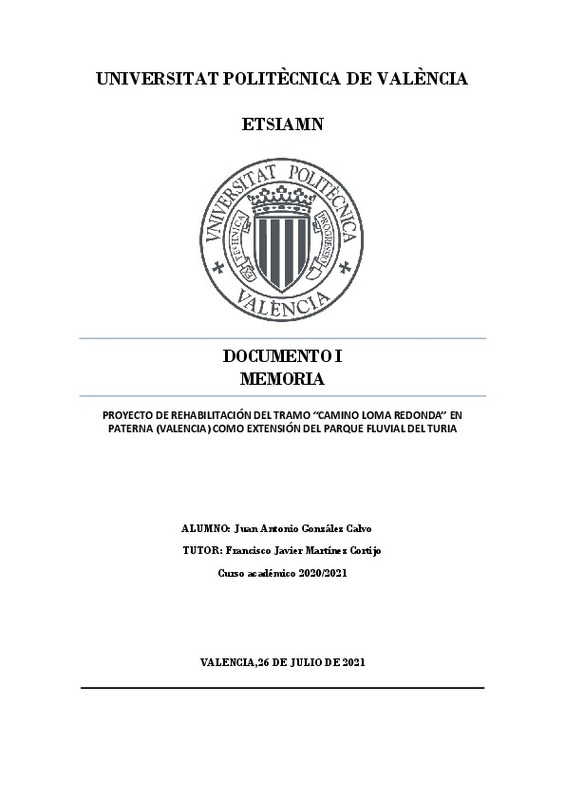|
Resumen:
|
[ES] El proyecto en cuestión se sitúa en la ribera del río Turia a su paso por el término municipal de Paterna, en la provincia de Valencia, más concretamente entre las acequias de Moncada y Quart de Poblet, al norte y ...[+]
[ES] El proyecto en cuestión se sitúa en la ribera del río Turia a su paso por el término municipal de Paterna, en la provincia de Valencia, más concretamente entre las acequias de Moncada y Quart de Poblet, al norte y sur, respectivamente. Este pretende ser una extensión del parque fluvial del Turia, declarado Parque Natural del Turia con los DECRETOS 43/2007 y 42/2007, por el que se aprueba el Parque Natural del Turia y el Plan de Ordenación de los Recursos Naturales del Turia, respectivamente y que recorre el cauce del río desde el municipio de Pedralba a Quart de Poblet. El río Turia-Guadalaviar y su ribera presenta gran variedad de ambientes, que determina una gran variabilidad en la composición de la flora y fauna existente a lo largo de todo el recorrido, acompañado del alto aprovechamiento agrícola y ganadero.
Se pretende recuperar un tramo de 2 ha, de los cuatro que componen el proyecto global a realizar. La alta degradación de la zona con el paso del tiempo ha dado paso a la invasión de vegetación adventicia desplazando así a la vegetación autóctona, destruyendo la biodiversidad y causando grandes alteraciones en los ecosistemas naturales.
Por tanto, se requiere de una actuación inmediata con el objetivo principal de recuperar la zona degradada, implantar zonas verdes a partir de vegetación autóctona bien adaptada a la climatología - edafología de la zona y la creación de áreas recreativas con huertos urbanos como pilar fundamental, que permitan a los ciudadanos hacer uso de los recursos naturales y de la misma manera proporcionarles una educación medioambiental sostenible que permita a la ciudadanía ser productora de sus propios alimentos asegurando una alimentación sana y de calidad, promoviendo la integración familiar y vecinal.
Es importante elaborar una estrategia de rehabilitación de la zona de forma gradual puesto que realizar una réplica de las condiciones iniciales influiría en la viabilidad del proyecto puesto que hay que abordar de forma paralela el desarrollo del ecosistema natural a la vez que este interacciona con las actividades de la sociedad. De la misma manera, se propondrá una rehabilitación en consonancia con el resto de los tramos, para generar una transición paisajística adecuada entre ellos.
Por tanto, las prioridades se basan en la recuperación del ecosistema autóctono degradado, dotación a la ciudadanía de zonas verdes con uso recreativo que sirva como punto de unión entre poblaciones y la revalorización del patrimonio medioambiental.
[-]
[EN] The project is located on the Turia's river banks as it passes through the municipality of Paterna, in the province of Valencia, more specifically between the Moncada and Quart de Poblet ditches, to the north and ...[+]
[EN] The project is located on the Turia's river banks as it passes through the municipality of Paterna, in the province of Valencia, more specifically between the Moncada and Quart de Poblet ditches, to the north and south, respectively. This is intended to be an extension of the Turia river park, declared Turia Natural Park with DECREES 43/2007 and 42/2007, which approved the Turia Natural Park and the Turia Natural Resources Management Plan, respectively. and that crosses the riverbed from the municipality of Pedralba to Quart de Poblet. The Turia-Guadalaviar river and its bank presents a great variety of environments, which determines a great variability in the composition of the existing flora and fauna along the entire route, accompanied by high agricultural and livestock use. It is intended to recover a section of 2.9 ha, of the four that make up the global project to be carried out.
The high degradation of the area over time has given way to the invasion of adventitious vegetation, thus displacing the native vegetation, destroying biodiversity and causing great alterations in natural ecosystems. Therefore, immediate action is required with the main objective of recovering the degraded area, implanting green areas from native vegetation well adapted to the climate - soil science of the area and the creation of recreational areas with urban gardens as a fundamental pillar, that allow citizens to make use of natural resources and in the same way provide them with a sustainable environmental education that allows citizens to be producers of their own food, ensuring a healthy and quality diet, promoting family and neighborhood integration. It is important to develop a strategy for the rehabilitation of the area gradually since replicating the initial conditions would influence the viability of the project since the development of the natural ecosystem must be addressed in parallel while it interacts with the activities. of the society. In the same way, a rehabilitation will be proposed in line with the rest of the sections, to generate an adequate landscape transition between them. Therefore, the priorities are based on the recovery of the degraded autochthonous ecosystem, providing the citizens with green areas for recreational use that serve as a point of union between populations and the revaluation of the environmental heritage.
[-]
|




![[File]](/themes/UPV/images/mime.png)



